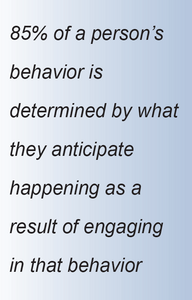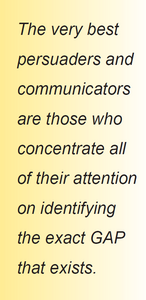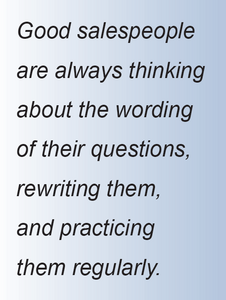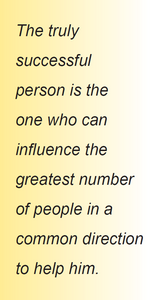One of the hallmarks of the successful person in every field is that he is influential and persuasive in his interactions with other people. He has the ability to get other people to cooperate with him to achieve his goals and fulfill his aspirations. The truly successful person is the one who can influence the greatest number of people in a common direction to help him get more of the things he wants in life…
Sometimes I ask my public seminar audiences, “How many people here are in sales?” I asked this of a group of accountants not long ago. It’s interesting to watch how people respond to that question. There are always a few people who will raise their hands, and then another and another, and soon perhaps half the room have their hands up, even though they are in fields such as management, administration, finance, and accounting.
I then smile and ask again, “Now, how many people here are really in sales?” At this point, the light goes on and virtually every single person in the room raises their hand. We all smile and laugh a little bit at the realization that each of us is in the business of selling every single day.
The pivotal question with regard to selling is whether or not you are good at it. Everybody is in sales. From the time you get up in the morning until the time you go to bed at night, you are continually negotiating, communicating, persuading, influencing and trying to get people to cooperate with you to do the things that you want them to do. If you are poor at sales, then you are merely a recipient of influence. This means that you will be continually influenced and persuaded by others. If you are good at sales, it means that you will be an agent of influence and you will be constantly influencing and persuading others in the direction that you want them to go.
All top executives are excellent low-key salespeople. All effective parents are wonderful salespeople. All effective children are very good at selling ideas to their parents. Excellent employees are very effective at getting their bosses to do things, and getting their coworkers to go along with them and cooperate with them in getting the job done. Everyone who is effective in virtually any area of life that involves other people is an excellent salesperson of some kind.
Your job is to become very, very good at selling. Over the years, unfortunately, a stigma has grown up around the selling profession. Many people feel that selling is a lowlevel type of activity and they don’t like to be associated with it. There are virtually no colleges or universities that have a Faculty or Department of Selling, even though 14.7 million Americans make their living from selling something to someone. It is the largest single, identifiable occupational group in the United States. Salespeople are the movers and shakers in every business and industry. They are the key people who create the demand for all the products and services that keep everyone employed at every other occupation.

Virtually every single piece of financial information in the newspapers and on television and radio has to do with selling in some way. The entire stock market and all the activities associated with it are simply a series ofreports on the prices of stocks, bonds and otherfinancial instruments as they are bought and soldon a daily basis. And their prices and values arelargely determined by the sales of the productsand services that they represent. Companies riseand fall based on whether or not they are capableof selling sufficient quantities of their products orservices at sufficient prices in competitive markets.Everything is sales.
Now I’m going to discuss a fundamental principle of all sales. Whether or not you have clearly defined it, you know about it and you are either using it, or having it used on you, almost every hour of every day. I call it “GAP Analysis.” It is the business of clearly defining what it is that your idea, product, service or concept can do for a person and then showing them how they can achieve their goals with what it is you want them to buy.
THE ABC THEORY
There is what you might call an “ABC Theory” of human motivation. It is very simple but also quite powerful. It is essential that you understand it in all your interactions with others. “A” stands for antecedent, or the things that come before an event, activity or decision.
“B” stands for the behavior that an individual engages in as the result of a stimulation of some kind.
And “C” stands for the consequences of a particular behavior, based on the antecedent that motivated that behavior.
Here’s what I have found out in my research into human motivation. I have discovered that 15% of the reasons that a person engages in a particular behavior are determined by what has happened in the past, the antecedent. But fully 85% of a person’s behavior is determined by what they anticipate happening as a result of engaging in that behavior.
Economists call this “Rational Expectations Theory.” It is at the heart of modern economic analysis. It simply says that people behave on the basis of their rational expectations, of what they think is going to happen if they buy or sell a particular product or service, or engage in any particular action.
In fact, since everyone is emotional, people tend to buy based on how they anticipate feeling as a result of owning and enjoying a particular product or service. They look forward to the feeling they expect to enjoy, and they make their decision based on whether or not that feeling is more valuable to them than the money they will have to part with, or than something else that they could buy with the same amount of money.
Let me give you a simple example. You sit down to have lunch or dinner and you look at the menu. As your eyes go over the menu, you settle on the item that you think will give you the greatest pleasure in eating out of all of the other items on the menu. This doesn’t mean that the other items are not as good tasting as the one you choose. It simply means that, at that moment, you feel, rightly or wrongly, that the items you choose will give you the greatest satisfaction and pleasure of all the items that are available to you.
This is exactly the way you fill your plate when you go to a buffet. This is the way you shop when you go to the grocery store. This is the way you buy clothes, anticipating how you will feel wearing a particular item of clothing, as compared to the other items that are available at the same time and at the same price. Everything you do is donein anticipation of the emotion or feeling that you experience if your purchase decisionis successful.
In selling or persuading anyone to do anything, there is another Theory of motivationthat is equally as important and as powerful as the first one I just discussed.
In thissecond theory, “A” represents a state of “Felt Dissatisfaction.” This means that the individualis not happy or satisfied in their current situation or condition.
The “C” represents a state of greater satisfaction. If the individual moves to this stateof greater satisfaction, he or she will relieve the felt dissatisfaction that he or she hasin their current situation.
The “B” of this ABC Theory is the product, service, idea, action, or activity that you aretrying to persuade the person to acquire or engage in.So, to repeat, the “A” is the existing state of dissatisfaction.
The “C” is the future anticipatedstate of greater satisfaction or relieved dissatisfaction. The “B” is what you areoffering, in one way or another.
We call the “B” part of this formula the GAP between where the person could be and where the person would ideally like to be. A sale, or an effective act of influence, getting the person to do something that they would not have done in the absence of your influence, is only possible when a GAP exists between the real current situation of the other person and the ideal situation that they would like to enjoy. You can only get a person to act when there is a GAP between their current life and work and their desired life and work.
FOCUS ON THE GAP
The very best persuaders and communicators are those who concentrate all of theirattention on identifying the exact GAP that exists. They then focus on that GAP, wideningit in every possible way until the prospect begins to feel more and more dissatisfiedwith their current situation and more and more desirous of enjoying the future, idealsituation which is achievable by the use of your product, service or idea.
Let me give you an example. I was quite happy with my car until very recently. It was a nice car, it was paid off and it was running fine. Then I took it in to the garage for a regular check-up and service. The dealership did an excellent job of analysis and came back to me with the sad fact that the car not only required new tires all around, but a complete new set of brakes, wheel alignment, and a lot of other things. The total service cost was going to be about $3,000.

You can imagine my reaction. I was shocked. I had no idea that the car required that much service. Well, I thought, what the heck, at least it’s cheaper than buying a new car. Then the salesman at the dealership pointed out to me that the car would drop another $2,000 in value at the
turn of the model year, which was coming up in about 60 days. He told me that if I kept the car, and repaired it, I would lose $5,000 off the total value of the car which I could never recover.
Suddenly I went from complacency about my car to dissatisfaction, and then to great dissatisfaction and an intense desire to improve my condition in some way. The sales-man for the dealership then went on to explain that he could take my car in as a downpayment on a brand new luxury automobile, with no cash out of my pocket, and hecould spread the payments over three, four or five years so that the cost to me wouldbe very reasonable. At that, all my resistance collapsed. I went from being satisfied orcomplacent to being so dissatisfied with my existing situation that I turned around andbought a brand new, expensive luxury car, committing myself to tens of thousands ofdollars of payments over the next three years and surprisingly enough, I drove awayhappy.
KEY POINTS
Here are some of the key points in GAP Analysis and in persuading people to movefrom where they are to where you want them to be.
Remember, that people buy solutions to their problems, not products or services. In fact, as a salesperson, you are a problem finder rather than a vendor. The more you focus on the problem or GAP that exists between the real and the ideal in the customer situation, the faster you will find a place where your product or service can plug the GAP.
The bigger the problem that the person has, the bigger the potential sale. One of the most powerful questions you can ask a person is, “How much is that problem costing you?” Help the person to identify not only the obvious and direct costs but the not so obvious and indirect costs.
Ask the prospect, “What are the implications, or what is the meaning of that problem to you?” “What other things does it affect in your work or personal life?”
The most astute people are those who are capable of finding a small GAP and thenexpanding it into a wide GAP. They are capable of finding a small problem or small dissatisfaction in the mind of the prospect and then, by questioning and commenting,they expand it and increase it until the prospect begins to develop an intense desirefor the solution that they are offering.
ASK YOURSELF
If you are selling to companies, you have to ask what the decision makers in the companywant to accomplish. What is the GAP between where they are and where they want tobe? And the GAP in selling to companies is always determined by the responsibilitiesof the decision maker. How is the decision maker rewarded, and for what? What is itthat the decision maker has to do to earn the respect, esteem and support of his or hersuperiors and co-workers? On what basis, and for what results, does he or she get paid?
One of the deepest subconscious needs of all people is the need for self-esteem, feelingvaluable, important and worthwhile. If you can find out what a person needs todo to increase their self-esteem and their perceived value in their organization, andthen show them that by using your product or service, they can earn the approval andappreciation of the people around them and above them, they will often be highlymotivated to buy what you are selling.
PINPOINT DISSATISFACTION
When you meet a prospect for the first time, you will find that they are usually unawarethat a GAP exists between where they are and where they could be. They will say thingslike, “I’m not interested,” or “I can’t afford it,” or “We’re quite happy with our currentsituation.” These are normal and natural reactions. No one likes to change. But all thismeans is that the person has not yet learned that there is a GAP between where he orshe is and where he or she could be using your product or service.
Your job is to uncover dissatisfaction, or to create one. In fact, you will often find aperson who is quite content doing what they are doing. Your job is to describe a state of even greater satisfaction that they could enjoy if they did something different.Virtually all advertising on television and everywhere else is aimed at showing peoplehow much better off they could be with a product or service that they have not yetacquired. This is your job as well.

One of the best questions you can ask, in dealingwith a complacent prospect, begins with thewords, “Were you aware?” Were you aware thatit is now possible to, be or have this particular satisfaction? Very often, the prospect is uninterestedbecause he or she is not aware of howmuch better off he or she could be with what itis you are selling. This is why you must be positive,patient and persistent. Don’t let the initialsales resistance or rejection of a customer affect you or get you down.
GAP Analysis is based on asking good questions. Questions focused on problems thatthe prospect might have hold the prospects attention. This is why there is a directcorrelation between good questioning techniques and sales success. The more and better questions you ask aimed at finding a problem or uncovering a dissatisfaction,the more interest the prospect will have and the more sales you will make. The person who asks questions has control. Good salespeople are always thinking about thewording of their questions, rewriting them, and practicing them regularly before theyget face-to-face with the prospect. Poor salespeople, on the other hand, get face-tofacewith a prospect and then try to make it up as they go along.
GAP ANALYSIS QUESTIONS
Here are a couple of great questions for GAP Analysis. The first is the magic wandtechnique. You imagine that you have a magic wand that you could wave over theprospect’s situation and you ask this question, “Mr. Prospect, if this situation were absolutelyperfect in every respect, what would it look like?” Then, remain completelysilent. When the prospect begins to describe how his situation would look if it wereperfect, he is in fact describing the GAPS that exist between what he is currently doingand where he could be in the future. If you have a product or service that can bridgethat GAP, you will create an opportunity to sell with this question.
Another wonderful set of questions begins with the words, “What if?” When you aska prospect things like, “What if you could do this; what difference would that maketo your current situation?” Or you could ask, “What if we could achieve this particularresult for you; what effect would that have on your current operations?”
Good questions that point to an ideal and desirable possible future grab the prospectsattention and start the prospect visualizing and imagining an ideal future state, exactlythe state that your product or service is meant to achieve.
BE “PROBLEM FOCUSED”
The very best salespeople in every field are extremely problem focused. They practicetheir questions over and over again until their questions are perfect and have a realimpact on the thinking of the prospect.
The great insurance salesman Ben Feldman was a master at designing powerful questions.Whenever he was talking to an insurance prospect who was not interested andcouldn’t afford it, he would ask questions such as, “Mr. Prospect, will your widow beable to dress as well as your wife?”
This kind of a question would really get the attention of a businessman who had no idea that his entire estate could be consumed by taxes if he didn’t make provisions toinsure for his family while his business was still thriving.
IDENTIFY NEEDS
Your job in selling and persuading is to identify the real and most pressing needs ofyour prospect. You do this by continuing to ask questions and by encouraging theperson to tell you what would have to happen for him or her to be completely happyin a particular situation. Once you have become completely clear regarding your prospectsneeds, you then show him or her, in what is called the presentation part of theprocess, how his or her needs can be most ideally satisfied by what it is you are offering.
You don’t try to push a person into making a decision. Instead, you lead them gentlyto the decision by showing them their problem or GAP on the one hand, and by showingthem your solution or way of bridging the GAP on the other hand. You then tellthem that your solution is exactly what they really want and need to get from wherethey are to where they want to go.
A final key to effective selling through GAP Analysis is to share some of the experiencesof previous people that you have persuaded to purchase your product or service. Usethird party references, testimonials and anecdotes. Say things like, “I have a very goodcustomer who had a similar situation to yours not long ago, and this is what he wasable to do with our product.” You then go on to explain a success story of someonewho had a similar GAP and who was able to bridge the GAP in a cost effective way byaccepting your recommendation.
Whenever you want to persuade anybody of anything, GAP Analysis is the key. Slowdown and instead of trying to overwhelm them with reasons and rationales for doing what you want them to do, ask questions aimed at uncovering their current problems,needs and dissatisfactions. Listen carefully to the answers they give you and askquestions to help them expand on the answers. Take a few moments to feed theiranswers back to them to show them that you were really listening and that you reallyunderstand their problems.
You then position yourself to influence and persuade the prospect by showing himor her how your product or service just happens to be the ideal way to solve theirproblem, satisfy their need or achieve the goal that they have. When you take thislow-pressure approach to getting people to do what you want them to do, they willbuy from you with pleasure and they will recommend you to their friends. They willfeel like they are being helped to improve their lives rather than being pressured intobuying something that they may not want or need.
SELLING IS A LEARNED SKILL
The wonderful thing about selling is that it is a learned skill. No matter where you are in your level of selling ability today, by continual practice at the business of finding problems that your ideas, products and services can solve, you can become better and better, and more and more persuasive in everything you do and with everyone you meet. And the more effective you are at selling, the more successful you will bein every other part of your life as well.

